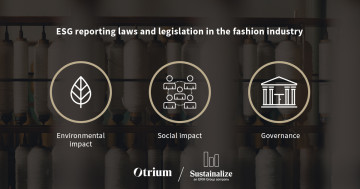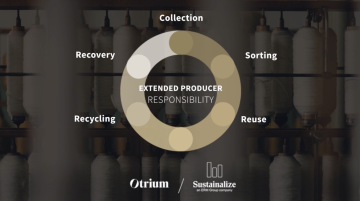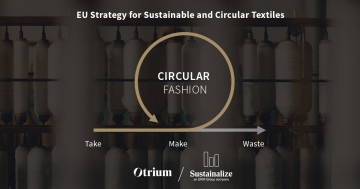Conscious
Unravelling sustainability laws in fashion - ESG reporting laws and legislation

We want to help our brand partners, both present and future, keep on top of the newest and forthcoming laws and legislation around sustainability and achieve their Environmental, Social, and Governance (ESG) goals.
19 OCTOBER 2022
At Otrium, we’re committed to a future where all clothing is worn, by providing a global solution to unsold inventory and changing the way clothing is created and sold. We want to help our current and future brand partners stay on top of new and forthcoming laws and legislation around sustainability and achieve their Environmental, Social, and Governance (ESG) goals.
In collaboration with Sustainalize, a leading corporate sustainability consultancy, we’re launching a series of blog posts aimed at simplifying these new laws and legislation. These posts will also contain guidance to help fashion brands comply with these policies.
In this series, we guide you through the three most important upcoming reporting laws and legislation in the EU to give you a short insight into similar legislation that is being introduced in the US and the UK.
The CSRD: Explained
The Corporate Sustainability Reporting Directive (CSRD) is the new EU legislation that requires companies to report on their environmental and social impact activities.
The CSRD aims to ensure that businesses report reliable and comparable sustainability information. This helps to better evaluate and benchmark the sustainability performance of companies. The objective is that this will encourage companies to develop a more responsible business approach.
The CSRD requires companies to disclose the following areas:
- General information: strategy and business model, governance in relation to sustainability, and companies’ materiality assessment of sustainability impacts, risks, and opportunities.
- Environmental matters: climate change, pollution, water & marine resources, biodiversity, and circularity.
- Social matters: regarding own employees, people working in the value chain, affected communities, and end-consumers.
- Governance: risk management & internal control, and business conduct.
The CSRD also emphasises due diligence (a continuous process to help enterprises identify risks relating to human rights, labour rights and the environment with a view to ending, preventing or mitigating those risks) by requiring reporting on:
- the incorporation of due diligence in governance and organisation;
- stakeholders’ engagement;
- identification and assessment of adverse impacts (adverse impacts occurs when a decision, practice or policy has a disproportionately negative effect on a protected group, even though the adverse impact may be unintentional);
- tracking the effectiveness of these efforts and communication.
Which companies will be affected by CSRD?
All large companies will be held publicly accountable for their impact on people and the environment. To be more specific, the scope includes all EU companies that meet at least two out of the following three criteria:
- More than 250 employees
- Turnover that exceeds € 40 million
- A balance sheet that exceeds a total of € 20 million.
At a later stage, the CSRD will require any EU-listed company with more than ten employees with a turnover of more than 2 million or a balance sheet exceeding 2 million to disclose their sustainability information.
When will the CSRD come into effect?
Currently, the CSRD is under development. It’s expected to be implemented by January 2024. The application of the regulation will take place in the financial year starting on:
1 January 2024
– for companies in the scope of the Non-Financial Reporting Directive (NFRD). To report in January 2025
– for companies that are not presently subject to the NFRD, but meet at least two out of the three criteria named above. To report in 2026.
1 January 2026
– for listed small and medium-sized enterprises (SMEs). To report in 2027.
More standards are expected to be published in 2023. These standards will cover the sector-specific standards - including Textiles, apparel, Footwear & Accessories - and standards for SMEs.
Read more about the CSRD and its timelines here.

The EU Taxonomy: Explained
The EU Taxonomy is a classification system for economic activities. It’s created to address greenwashing by enabling market participants to identify and invest in sustainable assets.
Companies are required to disclose which part of their turnover, capital spendings , and operational spendings meet the criteria listed in the EU Taxonomy. To align with Taxonomy criteria companies should meet the technical screening criteria, the do-no-significant harm principles, and comply with the minimal social safeguards. The EU Taxonomy covers six environmental objectives:
- Climate change mitigation
- Climate change adaptation
- Sustainable use and protection of water and marine resources
- Transition to a circular economy
- Pollution prevention and control
- Protection and restoration of biodiversity and ecosystems
Which companies will be affected by the EU Taxonomy?
Three different groups will be affected by the EU Taxonomy:
- Financial market participants who are offering financial products in the EU.
- Large companies who fall under the scope of the NFRD and CSRD.
- The EU and the Member States when setting public measures, standards, or labels for green financial products or bonds.
When will the EU Taxonomy come into effect?
The EU Taxonomy will be implemented progressively since only requirements for climate change mitigation and adaptation have been officially published by the EU. The approximated timeline for non-financial undertakings is the following:
1. Companies under the NFRD must report their eligibility for climate change mitigation and adaptation for the fiscal year 2021 and alignment for the fiscal year 2022.
2. Financial market participants must report on their eligibility for climate change mitigation and adaptation for the fiscal years 2021 and 2022 and alignment for the fiscal year 2023.
3. For the other four environmental objectives in the EU Taxonomy, it remains unclear whether eligibility and/or alignment will be required for the fiscal year 2022. More guidance on this is expected by the EU by the end of this year.
4. Companies under the CSRD scope will have to report eligibility and alignment for the fiscal year 2025.

The CSDDD: Explained
The Corporate Sustainability Due Diligence Directive (CSDDD) concerns companies’ responsibilities regarding environmental and human rights impacts caused by their decision-making. This includes sustainable and responsible corporate behaviour throughout global value chains.
Companies will have to identify – and prevent, end or mitigate adverse impacts of – their activities on human rights and on the environment. Furthermore, large companies will be required to align their business strategy with the Paris Agreement limiting global warming to 1.5 °C.
This directive will allow for more transparency for consumers and investors and provide legal certainty for businesses.
The directive has been built upon the OECD due diligence guidance in 6 stages:
- Integrating due diligence into companies’ policies and management systems
- Identify & assess actual or potential adverse impacts
- Cease, prevent or mitigate adverse impacts
- Monitor the effectiveness of the due diligence policies and measures
- Publicly communicating how impacts are addressed
- Establish and maintain a complaints procedure
Which companies will be affected by CSDDD?
The CSDDD’s due diligence obligations would apply to the following large EU and non-EU companies:
Within EU:
- Group 1: All EU limited liability companies with more than 500 employees and a net worldwide turnover of more than €150 million will be required to report on their due diligence matters.
- Group 2: Other companies operating in defined high-impact sectors (including the textile industry) with more than 250 employees and a net turnover of €40 million worldwide and more will be required to publish an annual statement on their due diligence matters on their website. For these companies, rules will start to apply two years later than for group 1.
Outside EU:
Companies that are active in the EU with turnover threshold aligned with Group 1 and 2, generated in the EU. Although there is only a small amount of EU business that falls under this scope, SMEs will also be impacted when they have an established business relationship with a large company (for instance, if they are part of its value chain).
When will the CSDDD come into force?
The CSDDD is still at an early stage, and no concrete timeline has been published yet. We expect more information on the timelines by the end of this year. Once the CSDDD is adopted, companies will have around three years to prepare.
Similar legislation in the US and the UK
Similar reporting legislations are being introduced in the US and the UK:
US: Securities and Exchange Commission (SEC) proposed a new set of rules on climate-related disclosures for greater transparency for investors in March 2022.
The SEC requires companies to disclose:
- Climate-related risks and their actual or likely material impacts on the registrant’s business, strategy, and outlook.
- The registrant’s governance of climate-related risks and relevant risk management processes.
- The registrant’s greenhouse gas (GHG) emissions, which, for accelerated and large accelerated filers and with respect to certain emissions, would be subject to assurance.
- Certain climate-related financial statement metrics and related disclosures in a note to its audited financial statements.
- Information about climate-related targets and goals, and transition plan, if any
Which companies will be affected by SEC climate-related requirements?
The SEC’s proposal applies to all SEC registrants including foreign private issuers, even those with no publicly listed equities.
When will it come into force?
Scope 1 & 2 emissions:
- Large accelerated filers: reporting in 2024 on 2023 data
- Accelerated filers, non-accelerated filers: reporting in 2025 on 2024 data
- Small reporting companies: reporting in 2026 on 2025 data
Scope 3 emissions:
- Large accelerated filers: reporting in 2025 on 2024 data
- Accelerated filers, non-accelerated filers: reporting in 2026 on 2025 data
- Small reporting companies: N/A
UK: In 2019 the UK government committed in law to net-zero greenhouse gas emissions by 2050. This transition must be supported by a significant shift of investment into sustainable projects and green technology. The government published a Roadmap for Greening Finance in 2022 aiming for the integration of environmental factors in decision-making.
The roadmap has three phases:
- Informing investors and consumers: ensuring decision-useful information on sustainability is available.
- Acting on the information: mainstreaming sustainability information into business and financial decisions.
- Shifting financial flows: across the economy to align with the national net-zero commitment and nature-positive economy.
The roadmap is still under construction and aims to implement strong regulations, such as:
- The Task Force on Climate-Related Financial Disclosures (TCFD) provides recommendations for disclosing information about the risks and opportunities of climate change and will be mandatory by 2025.
- New Sustainability Disclosure Requirements will be introduced built on the TCFD, aiming to create an integrated framework for disclosures on sustainability across the economy.
- Development of the UK Green Taxonomy setting out criteria to define environmentally sustainable economic activities following six environmental objectives: climate change mitigation and adaptation, protection of water and marine resources, circular economy, pollution, and biodiversity.
These directives are not directly linked to the textile industry, however companies will be required to comply and align with the requirements. These directives are still in construction and at an early stage, new publications and modifications are expected in the next months and over 2023, for general and sector-specific requirements.
For the CSRD, new draft papers are expected in 2023 including sector-specific requirements for the textile industry. The EU taxonomy is foreseen to publish the four other objectives by the end of this year, in which the textile industry is expected to be in the economic activities contributing to achieve these four objectives.
Sources
CSRD:
EU Taxonomy:
CSDDD:
SEC:
9. SEC.gov | SEC Proposes Rules to Enhance and Standardize Climate-Related Disclosures for Investors
Greening finance:
More from Otrium
See all articles
At Otrium, we’re constantly working towards making the fashion industry smarter and less wasteful. We also want to help our brand partners, both present and future, keep on top of the newest and forthcoming laws and legislation around sustainability and achieve their Environmental, Social, and Governance (ESG) goals.
So, in collaboration with leading Corporate Sustainability Consultancy Sustainalize, we’re launching a series of blog posts aimed at simplifying these new laws and legislation. These posts will also contain guidance to help fashion brands comply with these policies. We hope they prove to be useful.
First up, is Extended Producer Responsibility (EPR). What is it, and why do fashion brands need to know about it?
EPR - an explanation Broadly speaking, EPR is a waste management concept aimed at reducing pollution and landfill use, while increasing recycling rates. In fashion industry-specific terms, it’s a policy whereby brands bear a significant degree of responsibility for the environmental impacts of everything they produce, taking the whole life-cycle of garments and accessories into account.
It’s not a new idea - it was first introduced over 30 years ago - but the importance of developing more circular systems for dealing with all textiles is becoming ever more apparent. EPR is intended to reimagine how every company and organisation sources and uses their materials, plus how they dispose of and reuse them.
What EPR would mean
The results of introducing an EPR policy could:undefinedundefinedundefinedCurrently, the EU’s only mandatory EPR is in France. But several European countries are investigating similar schemes for textiles including the Netherlands and Sweden. The European Commission is considering EPR as a general regulatory measure to promote sustainable textiles and better recycling for textile waste. The UK government has also committed to review and consult on an EPR scheme. Over in the US, various undefined and coalitions are lobbying policymakers to make EPR a reality there too. It’s not clear whether any of these will become mandatory, or even coordinated across countries. Either way, EPR and everything it potentially involves is an important consideration for everyone in the fashion industry.
EPR in France
France’s EPR policy was introduced in 2007 and passed into law to cover end-of-use clothing, linen, and shoes in January 2020. The policy is governed by Refashion (formerly Eco TLC), an accredited non-profit organisation, which represents 95% of the French textile industry and is responsible for the collection, recycling, and recovery of used textiles. The destruction of unsold textile products is forbidden under law.
France’s target for 2022 is to collect 50% of all the textiles put on the market, and from this collection, reach 95% of reuse or recycling of textiles, and a maximum of 2% waste. Policymakers have also implemented an extension of circularity on transparency of the production, as well as the bonuses and penalties paid by the manufacturers and information on potentially dangerous substances.
EPR in The NetherlandsThe Netherlands has a draft regulation that focuses on garments and home textiles.All producers in the Netherlands, as well as external producers who market within the country (including ecommerce), need to appoint a legal entity to carry out the EPR. By 2025, municipalities will have to collect textiles separately. The Dutch government has a target for 2025 that 50% of textile products should be recycled or reused. Producers are obligated to report their figures annually. By 2030, this target will increase to 75%. The estimated cost of waste management for producers is €0.09 to €0.28 per kilogram of textile.
EPR in SwedenSweden introduced an EPR for textiles from 1 January 2022. It will be phased in over several years with licensed textile collections starting on 1st January 2024. It’s hoped that from 2028 onwards, at least 90% of the textile waste collected by the new system will be reused or sent for material recovery. Sweden’s target by 2028 is to reduce the average amount of textile sent to landfill by 70%.
How to prepare for EPRWhile the whole industry waits to find out whether these potential EPR regulations will be set in stone, there are two different initiatives that brands can consider implementing to get ahead of the pack.

Conscious
Unravelling sustainability laws in fashion - EU Strategy for sustainable and circular textiles
At Otrium, we’re committed to a future where all clothing is worn, by ridding the world of unsold inventory and changing the way clothing is created and sold. We want to help our current and future brand partners, stay on top of new and forthcoming laws and legislation around sustainability and achieve their Environmental, Social, and Governance (ESG) goals.
So, in collaboration with leading Corporate Sustainability Consultancy Sustainalize, we’re launching a series of blog posts aimed at simplifying these new laws and legislation. These posts will also contain guidance to help fashion brands comply with these policies. We expect they will prove to be useful.
Our first blog post unravelled the Extended Producer Responsibility (EPR), and can be read undefined. Within this piece we’re focusing on the EU Strategy for sustainable and circular textiles, what it contains, and how fashion brands can contribute to and prepare for this new strategy. The purpose of this new strategyThe European Commission published the EU Strategy for sustainable and circular textiles to tackle problems in the textile industry. The proposal aims to decouple economic growth from the consumption of finite resources by making steps towards a circular European fashion landscape. If successful, the strategy would be beneficial both for businesses and the environment.Greater longevity for clothing and sustainability-focused product design are key to reducing the fashion industry’s negative environmental impact. When implementing the strategy successfully, the European fashion landscape in 2030 will consist of:undefinedundefinedundefinedundefinedTo reach this vision several key actions should be taken:
Subscribe to Our Newsletter
Get the newest discounts, brands, and drops.
Otrium
Customer service
Customer service
© 2016-2025 Otrium, except certain content provided by third parties
